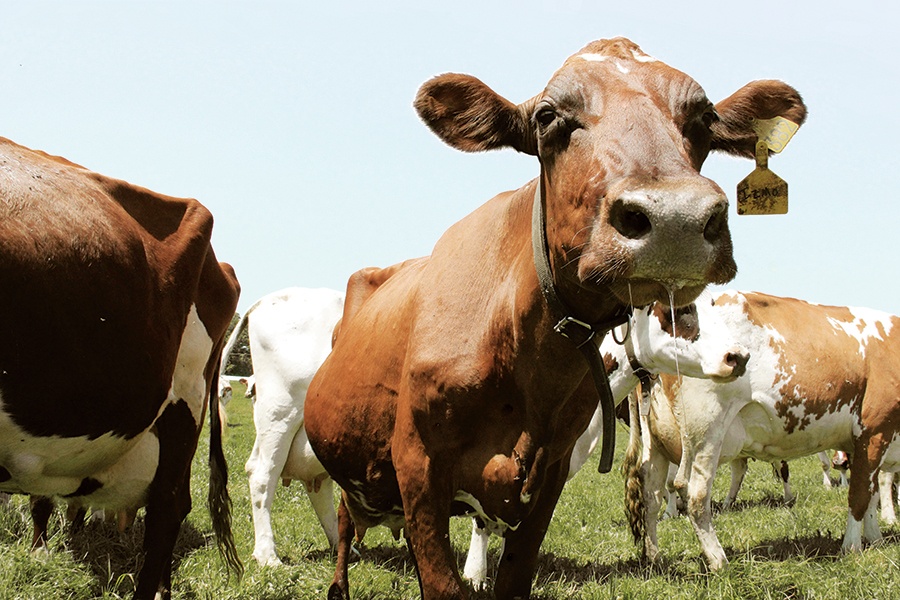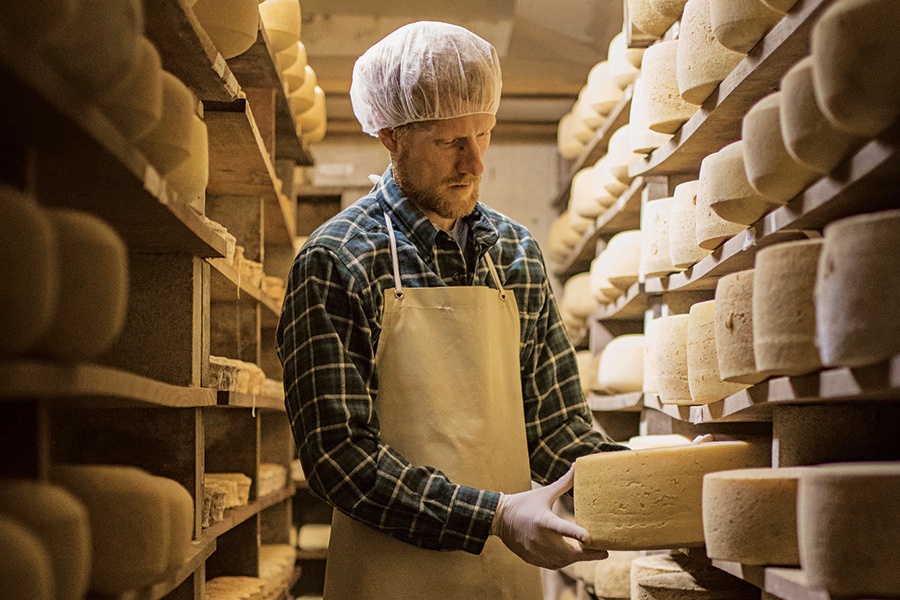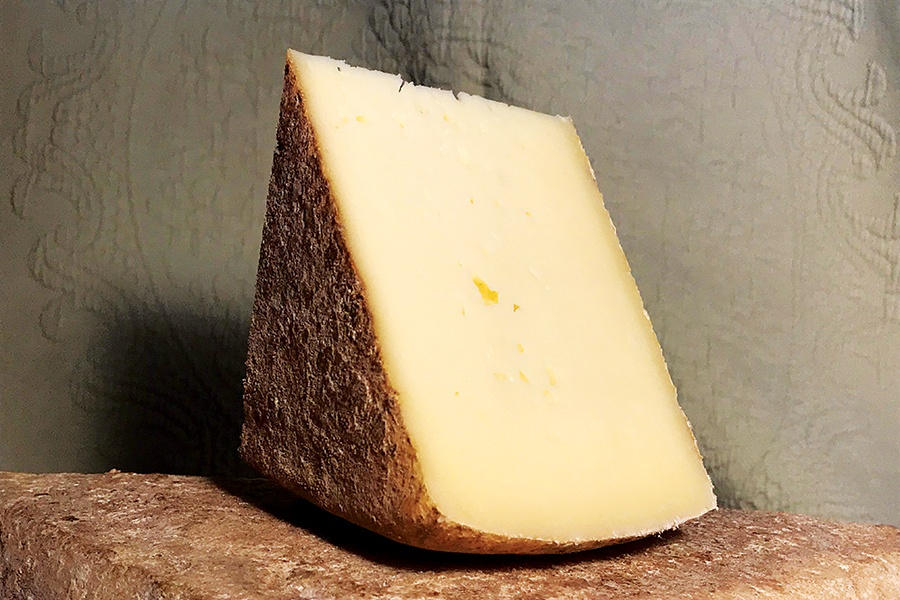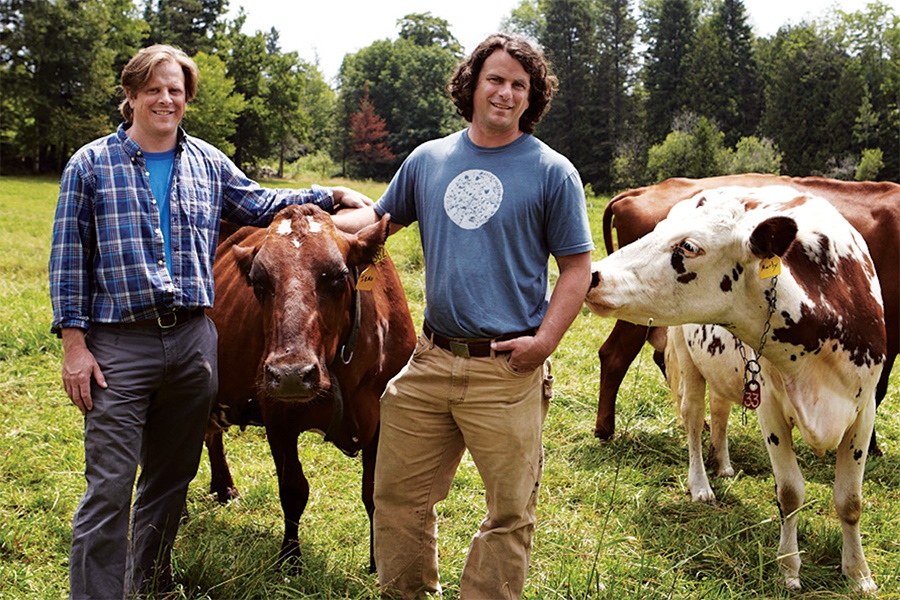How New England Cheese Is Taking Over the World
One glorious Gouda, goat cheese, and cheddar at a time.

Massachusetts-made Carlisle Honey and goat cheese from Ruggles Hill Creamery are a tempting pairing. / Photo by Nina Gallant
It was the leftover crumbs from a craggy slab of blue—pilfered from the blade of my chef’s knife during the last hour of a Saturday-night shift on the line—that awakened me to the depth of New England cheese. Ironically, I was in California.
My impromptu snack was a scrap of Bayley Hazen Blue from Jasper Hill Farm in Vermont. One thick slice flanked the cheese plate at the upscale San Francisco restaurant where, at the moment, I was sweating post-rush in my chef’s whites. The rind was mottled like a moon crater, the insides dense like fudge; it tasted like toasted nuts shot through with mild funk. Having been raised on blocks of supermarket cheddar and pre-sliced American-cheese packets in Boston, I’d never heard of Jasper Hill. But I knew that wherever it was in the world, I would one day make a pilgrimage to visit.
Why are my cheesehead friends always talking about rinds?
They’re an important factor when it comes to texture and flavor. Bloomy-rind cheese, for example, has enzyme-producing mold on the surface that breaks down the inside; that’s why a ripe Camembert is runny on the plate when you cut into it. With washed-rind cheeses, you’re literally washing off mold and encouraging a bacterial rind; they tend to be pungent.
—Catherine Donnelly, Vermont-based editor of the award-winning Oxford Companion to Cheese.
The following year, I moved to the Green Mountain State for work—and coincidentally met the ideal guide to the region’s dairy scene: Rory Stamp, a national cheese consultant and board member of the Vermont Cheese Council. We first bumped into each other at the cheese counter of a Burlington wine shop, drawn like moths to a backlit display of aged, crystalline Gouda; a friendship, plus a few rind-and-wedge primers, ensued.
Stamp, as it turns out, may be the world’s best cheesemonger. We’ll find out for sure this June, when he competes in the Mondial du Fromage in France, one of only two Americans—and 12 experts worldwide—to qualify for the honor. That a 28-year-old New Englander might bring home the gold isn’t such a surprise. Cheese is not a novel art in these parts; it’s an extension of our region’s cultural identity, one still actively stewarded by a modern generation of farmers and fromagers. “Cheese goes back to New England pragmatism,” says Stamp, who grew up in Scituate and Killington, Vermont, and who spent his formative years at Boston’s heralded Formaggio Kitchen. “It’s a value-added mentality that was established early through colonial trade: the ability to make a perishable good less perishable.”

New England’s artisanal cheesemaking thrives at Jasper Hill Farm. / Courtesy of Jasper Hill Farm
It’s also part of our practical history. Cheese begins on land, and New England’s number one crop by acreage is, by a long shot, forage—grass, hay, and pasture. And it’s rugged here: cold and rocky, the land carved up by hills, coastline, and mountain ranges like the Whites and the Long Trail. Winters stretch. This all means our landscape is better suited to raising ruminants such as cows and goats than it is to growing laser-flat expanses of almonds, artichokes, and romaine lettuce. It makes sense, then, that one of New England’s specialties is farmstead dairy—and the cheesemakers who turn milk, something quotidian and short-lived, into a product that’s storable and lasting.
All of which is to say that our region’s fixation with cheese isn’t exactly nascent. What is new: the rapidly increasing global acclaim afforded to our products, the talent of our makers, and the innovation of our processes. We see the result on menus: Massachusetts’ Great Hill Blue is now widely sought by the buzziest restaurants, from New York to L.A. to Dallas. We see it on the global stage: New England–made cheeses took top honors in eight categories at the most recent World Cheese Championship Contest, and many more finished elsewhere on the podium. We even see it in pop culture: In an episode of Top Chef earlier this year, chef-judge and star restaurateur Tom Colicchio called Jasper Hill’s Harbison his “favorite cheese in the world.” (The team that used it, which included two Boston chefs, won the challenge that episode.)
In other words: Watch out, Wisconsin. New England cheesemakers are now responsible for some of the most exciting, forward-thinking work in the industry—and are finally getting the recognition they deserve.
There’s a quote most cheesemakers know by heart, Stamp says. It’s from a 1957 book of essays by Clifton Fadiman. Cheese, says the author, is “milk’s leap toward immortality.” What have New Englanders come to immortalize? To find out meant a pilgrimage—with a few other stops along the way.

Bayley Hazen Blue is a signature cheese from the team at Jasper Hill Farm. / Courtesy photo

Bayley Hazen Blue is a signature cheese from the team at Jasper Hill Farm. It’s even featured in a mural at the Vermont property. / Courtesy Photo
The earliest New England cheesemakers imported ample inspiration from across the pond. How fitting, then, that the first stop on my journey is an underground cave in the middle of West Cambridge cradling one of the country’s leading storehouses of rare European cheeses. Ihsan Gurdal is its gatekeeper.
“This was my office in 1995,” says Gurdal, who co-owns Formaggio Kitchen with Valerie Gurdal, his wife. He is hunched at the shoulders in a temperature-controlled subterranean cellar, prime conditions for the labyrinth of underground caves Gurdal built to store a curated stash of one-of-a-kind wheels. “Above us, Appleton Street and Huron Avenue both slope down to this corner,” Gurdal says. “When it rains, there’s so much water flow past this point that it’s naturally the dampest, most humid spot in the business.” He used to hang money and paperwork to dry above his desk.
Gurdal built the cave, billed as the first of its kind in the country, in 1996. But that wasn’t the first time Formaggio made cheese history. In 1986, Gurdal launched a long-shot effort to cut out the middlemen in cheese importing, buying straight from the shepherds and makers after years spent building relationships across Europe. This is not the norm; among a small handful of shops in the country that import directly, Formaggio is the only one doing it in New England, according to Gurdal.
The cave bears the results. A makeshift fountain made from upturned gardening pots creates consistent water flow, tempering humidity levels for nearby rounds of French comté and Swiss tomme. Every selection has a backstory. Gurdal gestures to a row of aged-sheep’s-milk cheese from Marie-José Dupuis, a maker in the French Pyrenees from a town of fewer than 500 people. Shepherds move their animals every eight hours to different pasture, and cheeses are accounted for with handmade icons embossed on the rind. One wheel has “181” etched on it; it was made on the 181st day of the year.
What’s the difference between cow’s-, goat’s-, and sheep’s-milk cheese?
Typical cow’s milk is pretty low in fat. I think it’s much more bland when compared to goat’s milk, which has unique fatty acids that provide its flavor and texture. Sheep’s milk has much more protein and much more fat than cow’s milk, so it tends to be creamier and richer.
—C.D.
While Formaggio Kitchen is modern New England’s mecca for European cheese, it also represents the culmination of multiple centuries’ worth of the continent’s influence on our region’s own cheesemakers. “Cows arrived in Massachusetts from England right after the Mayflower,” explains Beth Falk, owner of Mill City Cheesemongers in Lowell and the executive director and a current board member of the Massachusetts Cheese Guild. The year was 1623. Falk explains that settlers came from parts of England where cheddar was the heritage—those dairy farmers founded the first herds in the not-quite-yet United States. Cheddar was also capitalistically efficient: In the span of a day, the curds’ core characteristics could be set, sealed in wax, and put in cold storage, requiring relatively little maintenance as the cheese aged. This made cheddar a crucial component of colonial trade, and a symbol of a budding agrarian community. In 1802 early residents of Cheshire, Massachusetts, gifted Thomas Jefferson a 1,235-pound wheel of cheddar made from a jury-rigged cider press. It sat in the White House for years, getting, well, ripe.
Driven by a combination of curiosity and proximity, New England cheesemakers and consumers still look to Europe for influence. That tendency has resulted in a collectively more-adventurous palate, at least according to Andy Hatch, co-owner of Wisconsin’s Uplands Cheese Company (maker of the most-awarded cheese in America, Uplands Pleasant Ridge Reserve). While Midwesterners crave simple curds such as Colby and Monterey Jack—“our cities tend to have more conservative food tastes,” Hatch explains—New Englanders gravitate toward unusual artisanal cheeses made by local dairies.
These small operations have their benefits. Namely, by eschewing the large commercial infrastructure that exists in, say, Wisconsin, they can produce micro-expressions of land and environment in a way commodity cheesemaking cannot. All of which begs the question: After centuries of outside influence, how exactly are we defining a distinct identity for New England cheese? I found the answer at my next stop.

Cheesemaker Mark Gilman creates award-winning wedges from Jersey cow’s milk at Connecticut’s Cato Corner Farm. / Courtesy photo

Cheesemaker Mark Gilman creates award-winning wedges from Jersey cow’s milk at Connecticut’s Cato Corner Farm. / Courtesy photo
Off a rural clip of Route 2 in the heart of the Constitution State, Cato Corner Farm is marked by a carpet of lolling pasture and a dirt path meandering to a weathered-wood barn house labeled “Cheese Shop.” There, mother-and-son team Liz MacAlister and Mark Gilman are working together on a revolutionary venture: making and aging wheels of one of the first truly American-original cheeses.
MacAlister, who’s been raising animals since the 1970s, began crafting cheese in 1997 as a way to make the family farm self-supporting. Cheese was a value-added product whose benefits would be twofold: preserve the land and earn a living. Today, Cato Corner Farm, located in Colchester, Connecticut, milks 45 primarily Jersey cows for its raw-milk cheeses, including a pungent, multi-medaled number dubbed Hooligan. Jersey milk is known for its richness—a depth ranging from melted ice cream to buttered popcorn—and raw milk, neither pasteurized nor homogenized, is as particular to place, and reflective of specific farming practice, as it gets. Tenaya Darlington, who spent the past decade writing and educating about cheese under the pseudonym “Madame Fromage,” puts it this way: The Cato Corner duo “are gentle souls making the stinkiest cheese coming out of the United States.”
Now Cato is one of three farm members of the Cornerstone Project, an initiative launched in 2016 by dairy journeyman and international cheese consultant Peter Dixon, of Parish Hill Creamery in Vermont. The project was Dixon’s response to a public call from the American Cheese Society for American-original cheeses with a taste distinct to their region. Underscoring how many American-made cheeses are offshoots of European styles, such contenders were few. So Cornerstone’s goal is to create cheese woven with a sense of place, as worthy of origin-based certification as Italy’s pressed oils and France’s fermented grapes.
Why is cheddar the most underrated cheese?
When people hear “cheddar,” they might think of that industrial kind at the grocery store—more of a processed than an artisanal variety. But there’s a whole range. Do a tasting with friends: Buy a full variety of cheddars—different ages and aging techniques—and compare them. They’ll all be a little different.
—C.D.
The tenets of the project are straightforward, if a challenge to execute. One, make cheese with your own raw milk in your own facility. Two, create traditional rennet made from calf’s stomach, a natural coagulant used to bind proteins in dairy. Three, work with salt from the most local source possible. All in all, the task is to “capture the flavor of our own farm,” Gilman says, with as many specific elements as possible.
Terroir, the characteristics of flavor imparted by natural environment, is a concept familiar to many a wine drinker. Likewise, regions in France have certified Appellation d’Origne Controlée (A.O.C.) cheeses that evolved over centuries to reflect one specific location. The Cornerstone Project aims to do something similar, but unlike those in France, these cheesemakers don’t have thousands of years of tradition and reputation to uphold. On one hand, “This makes it harder to categorize a whole region by a certain flavor or influence,” Gilman says. “But so much innovation is possible from the relative lack of historic parameters.”
So who are the other innovators building cheesemaking’s future in New England? Answering that question led me to a series of cellars buried some 30 feet underground in one of the region’s most isolated corners—and a pilgrimage five years in the making.

Fromage from Connecticut’s Cato Corner Farm, which has partnered with the Cornerstone Project, an initiative to develop an American-original cheese. / Photo by Michael Prince
Miles from phone service, I find Jasper Hill Farm by one lucid mural painted along the barn’s siding: A giant orb of the creamery’s lauded Bayley Hazen Blue cheese—at last!— rises over a bucolic landscape like a full moon, its cerulean mold craters shaped like cattle. For the fromager, this is the promised land: Jasper Hill’s bloomy and washed-rind progeny are among the most-awarded American cheeses in the world.
It’s March. It’s 7 degrees outside. Two hundred fifty cows are tucked away in the barn. I notice the silence first, snow falling like powdered glass over ragged woodland, so cold that everything has gone quiet. Beneath this flush of frozen pasture, wedged between the mountains of Vermont’s Northeast Kingdom and buried under a slab of leftover snow, seven underground vaults still teem with activity. The cellars hold seven varied microenvironments, manipulating cheese maturation by controlling the climate they age in. The team adjusts selective pressures—think: temperature, humidity, and oxygen levels—to steer microbial development (a.k.a. mold, yeast, and bacteria) in the cheese.
This may sound like work more suited to a laboratory than a farm, but it’s all a modern extension of old-fashioned New England agrarianism. Mateo and Andy Kehler purchased the property in Greensboro in 1999, during a period when long-established land began going up for sale, piquing the interest of developers and tempting flatlanders (non-Vermonters, pardon the slang) to build vacation homes along the lakes and mountains.
The brothers scooped up the 200-acre chunk of land to avoid being “priced out of paradise,” Mateo says after breakfast: toast spread with their Willoughby cheese, left out all night until buttery folds began weeping from the off-orange rind. Carpenters in a previous life, the Kehlers sought to develop an economic mechanism that would keep the landscape working while minding the area’s cultural legacy: dairy farmers. Here was cheese, a way to ensure the footprint of the farmer remained viable.

At Jasper Hill Farm, brothers Andy and Mateo Kehler oversee 100 open acres and seven cellars for aging cheese in distinct microclimates. / Courtesy photo

At Jasper Hill Farm, brothers Andy and Mateo Kehler oversee 100 open acres and seven cellars for aging cheese in distinct microclimates. / Courtesy photo
In 2003 the brothers began milking 15 heifers for their then-nascent farmstead cheese operation. Now, beyond their own herd, they form partnerships with larger local dairies, aging certain collaboration cheeses for nearby Cabot Creamery and Von Trapp Farmstead, and New Hampshire’s Landaff Creamery. “It’s intense labor. The hours are terrible. There are easier ways to make money than squeegeeing yards of cheese-floor concrete,” Mateo says. Those who make cheese have to love it, he continues, and people who love cheese that much? “We tend to be a quirky bunch.”
Fittingly, each of Jasper Hill’s seven cellars has its own intentional quirks—aroma, temperature, and even playlist. A trio of affineurs, French terminology for “ripeners,” wash young cheese to reggae. Paul Moretti—once a cabinetmaker who made Parmesan at home—is in charge of the yeasty, saline cellar where Alpine-inspired Alpha Tolman sleeps to the tune of classical violin. Cheesemakers caring for mold-ripened Harbison have the Pogues humming in the background.
“To make beautiful cheese is like building beautiful furniture,” says Nat Bacon, the creamery and quality manager. He has a point. The Kehlers once were carpenters; Moretti built cabinets. Cabinetmakers excel at routine and repetition, re-creating—again and again—the same thing with gradual yet constant refining. Both disciplines take something mundane and dispensable, be it scrap metal or excess milk, and make it valuable—even profitable. Both link years of knowledge and personal experience to capture something wild within a useful medium. In the case of cheese: within a rind.
As New England cheese endures some 400 years after those first dairy cows arrived on Bay State shores, our region’s cheesemakers aren’t just enduring—they’re excelling, and rightfully earning international notice alongside top producers such as Wisconsin and California. I think back to my first bite of Bayley Hazen Blue, how it traveled from Vermont all the way to my chef’s knife in California, bringing with it the flavor of grasses and raw milk, the hands of its maker. It tasted even better that March afternoon on the farm, wedged with a pocket knife in a calm, humid creamery overlooking mountain peaks. Mateo Kehler says it well: “Innovation happens on the fringes.”
New Englanders are revolutionaries at heart, after all.
Read more: The Ultimate Guide to New England’s Cheese Revolution


